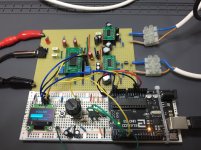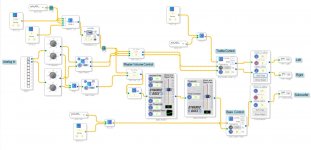A home for a NC502 hypex amp. Made for a fellow enthusiast.
Nice amp ) NC502MP is a great board.
I own it but I prefer the NC500MP double Mono. I found it more "holographic", the sound stage is better. This is often the case for dual mono amps
@orchardaudio The SMPS modules in this amp look very compact. Do you know who makes / sells them?
Looks like Murata 250w
@redjr
"After testing on my bench, I found that the SMPS600 and the amp did not play nice together due to excessive amount of inrush current from the SMPS to the amp. A different kind of soft-start was required, since the SMPS already had a soft-start built-in. What was needed was an inrush current limiter circuit between the SMPS and amp. I contacted xrk971, and with his help, an inrush current limiter PCB was born. It will be offered in his Esty store in the future. The prototype I tested worked fine and I was able to complete the project build. Note: This appears to only be an issue with some models of SMPS' and the amp. So if you're building this amp, please try your intended SMPS first, as it may work fine. xrk971 confirmed it worked with a different model of SMPS from Connex he used for testing. So this simply may be a one-off obscure occurrence. In fact, it worked with a lower voltage/power SMPS I tried as well - without the inrush current limiter circuit being necessary. The Inrush Current Limiter circuit is powered by the SMSP auxiliary 12v output."
Hi I have the same SMPS from the main rail is measuring 69.4v unloaded does you SMPS behave the same? I remember measuring when it was powering the amp, it read 48.1v or something close.
I recently got new amp and I'm using the same SMPS to power it but I think SMPS killed the amp. So I think its a good idea you are using an in-rush current limiter.
"After testing on my bench, I found that the SMPS600 and the amp did not play nice together due to excessive amount of inrush current from the SMPS to the amp. A different kind of soft-start was required, since the SMPS already had a soft-start built-in. What was needed was an inrush current limiter circuit between the SMPS and amp. I contacted xrk971, and with his help, an inrush current limiter PCB was born. It will be offered in his Esty store in the future. The prototype I tested worked fine and I was able to complete the project build. Note: This appears to only be an issue with some models of SMPS' and the amp. So if you're building this amp, please try your intended SMPS first, as it may work fine. xrk971 confirmed it worked with a different model of SMPS from Connex he used for testing. So this simply may be a one-off obscure occurrence. In fact, it worked with a lower voltage/power SMPS I tried as well - without the inrush current limiter circuit being necessary. The Inrush Current Limiter circuit is powered by the SMSP auxiliary 12v output."
Hi I have the same SMPS from the main rail is measuring 69.4v unloaded does you SMPS behave the same? I remember measuring when it was powering the amp, it read 48.1v or something close.
I recently got new amp and I'm using the same SMPS to power it but I think SMPS killed the amp. So I think its a good idea you are using an in-rush current limiter.
Last edited:
Murata / PQC250-54@orchardaudio The SMPS modules in this amp look very compact. Do you know who makes / sells them?
Hi. I'm new to the forum.
I'm building an amp using two PAM8320 mono 20W class D amps, with a TDA7439 audio processor for input selection, volume and tone control (driven by an Arduino I2C interface. I coded all the Arduino front-end myself).
Currently in prototyping on some perfboard & a breadboard. Experimenting with supporting components, hence the differences in the left and right amp sections. Sounds pretty good TBH, powered by my bench power supply with 9v at the moment.
Next up, is deciding on a PSU. I like the aesthetic of a linear supply but may add a 12v switching regulator afterwards to keep things stable. The digital side will have linear regulators (9v and 5v) as they both draw very little power.
I'm a newbie, so please be kind
I'm building an amp using two PAM8320 mono 20W class D amps, with a TDA7439 audio processor for input selection, volume and tone control (driven by an Arduino I2C interface. I coded all the Arduino front-end myself).
Currently in prototyping on some perfboard & a breadboard. Experimenting with supporting components, hence the differences in the left and right amp sections. Sounds pretty good TBH, powered by my bench power supply with 9v at the moment.
Next up, is deciding on a PSU. I like the aesthetic of a linear supply but may add a 12v switching regulator afterwards to keep things stable. The digital side will have linear regulators (9v and 5v) as they both draw very little power.
I'm a newbie, so please be kind
Attachments
Hi, the modules are completely my own design no off the shelf modulators or class d chips.
Specifications and test results all posted here:
Orchard Audio - Audio Power Amplifier, Home Audio, Home Stereo System | Orchard Audio - scroll down to see all of it.
Here are the specifications copied from my website:
- Gain: 16.8dB or 6.92
- Signal to Noise Ratio (SNR): 121dB (A-weighted)
- Residual Noise: 32uV (A-weighted)
- THD @ 10W: <0.0003% (-110dB) for 1kHz into 8Ω
- THD @ 0.25W: <0.0030% for 20Hz - 20kHz into 8Ω
- THD @ 10W: <0.0013% for 20Hz - 20kHz into 8Ω
- THD @ 75W: <0.0050% for 20Hz - 20kHz into 8Ω
- THD @ 150W: <0.015% for 20Hz - 20kHz into 8Ω
- THD @ 10W: <0.0004% (-108dB) for 1kHz into 4Ω
- THD @ 0.25W: <0.0030% for 20Hz - 20kHz into 4Ω
- THD @ 10W: <0.0025% for 20Hz - 20kHz into 4Ω
- THD @ 75W: <0.0092% for 20Hz - 20kHz into 4Ω
- THD @ 150W: <0.015% for 20Hz - 20kHz into 4Ω
- Frequency Response: DC - 80kHz+
- Sensitivity: 5Vin for 150W into 8Ω
- Sensitivity: 3.5Vin for 150W into 4Ω
- Input Impedance: 5kΩ fully balanced
- Output Power: 150Wrms
- Damping Factor: >550 @ 1kHz
Hi,
Forgot to ask, could you please tell us more about the OP Amps installed on your great modules ?
Hi,
Forgot to ask, could you please tell us more about the OP Amps installed on your great modules ?
OPA2211
What is the resistance of the sub coil?
I tested 3255 at 62V, over 400 watts in PBTL mode at 4 ohms
My sub coil is 4ohm.
Thanks for your information.
Yo amigos,
New DrMordor TPA325X amps with PFFB. (based on 360 Customs design)
These high ends TPA325X sound awesome. They are shoulder to shoulder with my Hypex Ncore.
- TPA325X chip
- Wurth / Epcos main caps
- Wuth / Ferro inductors
- Elna Silmic II buffer caps
- PFFB enabled
- OPA1602 / NE5532
- SMPS PSU / LLC / Softstart




New DrMordor TPA325X amps with PFFB. (based on 360 Customs design)
These high ends TPA325X sound awesome. They are shoulder to shoulder with my Hypex Ncore.
- TPA325X chip
- Wurth / Epcos main caps
- Wuth / Ferro inductors
- Elna Silmic II buffer caps
- PFFB enabled
- OPA1602 / NE5532
- SMPS PSU / LLC / Softstart




I just finished doing the measurements on Anand's (poseidonsvoice) build that uses my Class-D GAN BOSC modules.
https://orchardaudio.com/shop/ols/pr...plifier-module
He posted about it earlier in this thread. Anyway here are the measurements.
SNR is 120dB.
Great results ! nice amplifier.
As great as Murata PSU by the way ?
- Home
- Amplifiers
- Class D
- Class D Amp Photo Gallery








